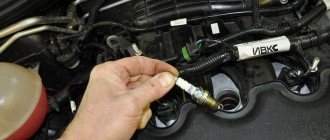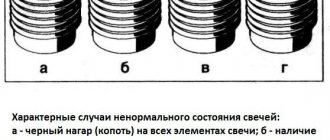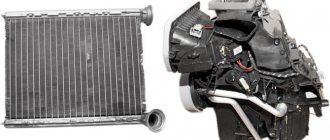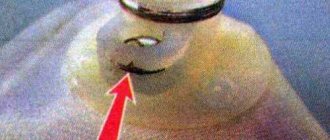A recent novelty of the domestic automobile industry - Lada Vesta - has become widespread among car enthusiasts. Despite the fact that the car has been in production for only a few years, owners are gradually beginning to encounter minor problems and periodic maintenance, which includes replacing spark plugs on Lada Vesta cars. This need is not a shortcoming of the machine or a serious breakdown; timely replacement of small spare parts will help in the future to avoid major repairs of the main moving parts.
↑ Features and purpose of spark plugs on a Lada Vesta car
Plugs are one of the most important components in the ignition system of any car; without them, it simply will not start. Using a discharge on the electrodes, the flammable fuel-air mixture is ignited. Engine power, efficiency and even toxicity of exhaust gases depend on the stable operation of igniters.
Lada Vesta cars produced from the factory can have two types of spark plugs:
- AU17DVRM (Russia);
- Brisk Super DR15YC-1 (Czech Republic).
Both of these models of ignition elements, according to reviews from car owners, have proven themselves well, they last well and do not cause problems.
Standard reel - article number and price
Let's look at the articles, the cost of the IKZ, you can navigate by price. Lately, counterfeit parts have become common. By buying such a fake, you reduce its use by half. In order for the car to work well, the choice of parts should be approached with full responsibility.
- 2112-3705010-12 JSC "SOATE", Stary Oskol - 1165 rubles.
- IKZ – 1000 rub.
- 2112-3705010-11 “ITELMA”, Moscow – 1215 rubles.
- 2112-3705010-13 “NORTH”, Novosibirsk – 1515 rubles.
As you can see, ignition coils are affordable and you can purchase them without significant damage to your wallet. How to distinguish a fake from a factory IKZ:
- The first distinguishing feature is that the original reel has a body made of plastic, while the fake one is made of metal.
- The fake part lacks special stamps and a lightning bolt symbol, which indicates high voltage. If you look closely at the contacts of a fake IKZ, you will notice that they are thicker and round. The factory number is marked with an oval on the original part.
↑ Signs of wear
It is usually recommended to replace the spark plugs after the vehicle has traveled a certain number of kilometers. It is not advisable to allow the wear of these elements to affect the operation of the engine and the entire ignition system.
But, if the igniters were not replaced in time, or the new ones turned out to be defective, then obvious signs of their malfunction will, first of all, affect the operation of the engine. The first sign is that the engine has become difficult to start and does not pull.
It may also trip or jerk and lose power. Sometimes wear of the ignition elements provokes increased gasoline consumption, as well as poor performance and overheating of the catalyst.
If traces of oil are found on the spark plugs themselves or the threads, this is a clear sign that the reflector caps also need to be replaced.
Conclusion
Provided that high-quality spare parts are installed, the average service life of the IKZ will be 50 – 60 thousand km. In the event of equipment failure, replacing the part on your own is not at all difficult.
When purchasing, carefully check the catalog numbers and serial numbers with the data indicated in the table.
Greetings, comrades. Buying a new car two years ago, I thought that I would forget like a bad dream the adventures with the repair of AvtoVAZ’s masterpiece under the proud name Lada 2110. When driving the brand new Vesta out of the showroom, I was sure that for at least three years I would not rack my brains over puzzles posed by engineers, assemblers and suppliers of my beloved auto giant, go through quests to find what is broken after all. Yes, and still a guarantee. Closer to the body. One morning I start the car and feel something is wrong, the speed is fluctuating, the engine is not working properly, the vibration at idle is more than usual. Has the engine been throttled? Well, what the hell, I thought, this is Vesta - a technological and qualitative breakthrough in our automotive industry, and all that... Did it really start again with a new car after 40 thousand kilometers of happiness, without repairs and puzzles with sorting out spare parts. After warming up, everything seemed to be back to normal, but at the first traffic light, when accelerating, the car began to twitch, stalled, and the check light came on. Super! I turned it off, started it, the check disappeared, it seemed to drive. But after a couple of kilometers there is again jerking, tripping and a check. Immediately to the nearest dealer, just in time for the opening. In their service, everything is very tightly scheduled and without an appointment it is impossible to get to the diagnostics, but I begged the electrician to come out with a scanner. The guy connected and saw two errors - misfires in the second cylinder and a shutdown of the fuel supply. He cleared the errors, found no new omissions, and let me go in peace. He told me to take out the fuel, change the gas station, and if everything happens again, then feel free to go to them for an appointment for diagnostics. Then I remembered that last night, as luck would have it, I refueled at the new Shell gas station, which had only opened a couple of days. I think they definitely filled the tanks with some kind of turbidity, either with technological waste or water. Immediately I started thinking that, at best, I was in the process of flushing the system or, in the worst case, in the pump, because there is no separate fine filter on Vesta and Renault. I stopped at Lukoil and, just in case, splashed on 100-octane gasoline to dilute it. I got to work without tripping, but the engine still doesn’t work right. In the evening, leaving work, everything happened again, but the check did not light up, and it seemed to jerk and throttle less, like gasoline.
At home in the evening I did not calm down, but still decided to check the candles. There were four-electrode platinum Beru UXF 79P, I have a blog post about them. To remove the coils I had to buy an 8mm Torx socket. Priora ignition coils and French Torx bolts are a very nice combination... A long 16 socket from the tool kit and with the usual movements, take all the spark plugs out.
30 thousand left and there were no problems with them, neither in cold nor in heat. The wells are clean except for the fourth, like all of them there are traces of oil, which is not critical. The sealant is applied crookedly and this is clearly visible. Ignition coils on spark plugs are unusual for me.
Reels from the factory come 2112-3705010-13 - PO "SEVER", Novosibirsk.
Just in case, I replaced the spark plugs with factory A17DVRM ones, which, based on the experience of owning a ten, I carried with me, and really hoped that they wouldn’t come in handy. I replaced the spark plugs, put the coils back in place, and lo and behold, the swallow seemed to have recovered... It seems...))) I drove around the city in the evening, it seemed to be gone... I was happy, that means it was definitely the candles! Our gasoline will kill any candles, even such fashionable ones... The next morning, everything repeated itself exactly like yesterday, Groundhog Day. But now I know for sure that the source of the problems is not in the candles. I freaked out and went to another dealer, fortunately we have three of them. I talked the guarantee man into accepting him without a queue or an appointment. The electrician found the same errors on the tablet that his colleague had made the day before. I cleared the errors, swapped coils 2 and 3. I did not record any more errors. The electrician admitted that it might be a problem with the coil, but there would be no replacement, since then there should be misfires in the third cylinder, but there are none. It was then that I was overcome by nostalgia for the ten))) often my ten pleased me with similar riddles and puzzles, and also when visiting the service, the symptoms traditionally disappeared... So, I insisted on taking a ride around the city, but the engineer refused, saying there was no time, and I I got in here without a queue. In general, I made a victory lap around the city and again to the electrician. Of course, the scanner didn’t see any errors, and they politely said goodbye to me. The check will be on - you are welcome! Long live Vaz! While driving to work, my hysterical laughter repeatedly gave way to obscene epithets addressed to AvtoVAZ... Day three. This time I prepared to fight an invisible enemy. Owning a ten has strengthened the spirit of a fighter in me, the experience of repairs in the field, the habit of carrying tools and spare parts with me, and other invaluable skills have again waited in the wings. I took out the ELM bluetooth adapter from AliExpress and installed OpenDiag. For two years he lay idle, but not in vain. I start it cold, and voila, the misfire is now in the third cylinder. That's it Mikhalych!))) Neither shitty gasoline, nor spark plugs even after 30 thousand miles, and nor my crooked hands were the reason for this pandemonium. The ignition coil is like that! I somehow didn’t feel like going to the dealer again, and I don’t have time to spend half a day again with a warranty; I really need a car today. Out of old habit, I go to BB (aka Auto 49), when I had a ten, I was a frequent customer there)))). There was no exactly the same coil. Bought 2112-3705010-12 - ZAO SOATE, Stary Oskol.
Epilogue. The car is unrecognizable, it drives as before. There are no errors. I remembered that a week ago the car stalled a couple of times when starting hot. This means that the defective coil has long decided to die, I wonder how soon other coils will follow it.
Conclusion. You always have to be on alert with VAZs, but you won’t get bored))) All the best. Love your cars as they love you)))
The car jerks, there is no traction, vibration is felt, or the engine is rough; all these are symptoms of improper operation of the individual ignition coil (IIC). Other signs of a faulty ignition coil are the presence of errors 0301, 0302, 0303 and 0304, indicating misfire in one of the cylinders. Let's look at a few simple ways to check the ignition coil with your own hands.
It is worth noting that the process of checking IKZ on modern Lada cars (XRAY, Vesta, Largus, Granta, Kalina and Priora) does not have significant differences. All actions are performed in the same way.
↑ Replacement period
For a car, as for any other equipment, it is better to prevent the breakdown of any small spare parts with the help of timely maintenance than to experience difficulties with repairs in the future. Therefore, even when purchasing a completely new car, the owner is given a number of recommendations for operating the car and the necessary periodic maintenance.
AvtoVAZ, among other things, sets timing for replacing spark plugs for cars of the entire model range, including the new Lada Vesta. Plant specialists recommend changing them after every 30,000 kilometers. In fact, the resource of their candles, and any others that will be installed, is approximately twice as long. But due to bad gasoline and polluted air, it is possible that the igniters will fail the car owner at the most inopportune moment if they are not replaced within the specified period.
If you find oil in the spark plug wells
The Lada Vesta has an unpleasant flaw. Insufficiently reliable sealing of the engine between the valve cover and the cylinder head. Because of this, oil gets into the spark plug wells. The problem can be fixed at the dealer under warranty - you just need to re-glue the camshafts and reliably seal the engine. Or contact a service station.
The problem occurs on cars where the manufacturer does not provide gaskets in the classical sense. An anaerobic sealant is used, which seals the cylinder head, camshaft bed and valve cover together.
In this case, given the inconsistent build quality of AvtoVAZ, there is a problem with the seal of the planes connecting in the upper part of the cylinder head. And since the oil pressure in the cylinder head is quite high (about 3-4 bar), the oil begins to flow into the spark plug wells
What are the dangers of oil getting into spark plug wells?
Due to oil leakage, the spark plugs and ignition coil fail faster. The spark plugs and coil do not break immediately after oil gets on them. But over time, the parts will fail - they are not designed to work in such conditions.
Many drivers note that due to oil in the spark plug wells, the engine begins to stall. It may also be harder to start. This is especially true during the cold season.
Damage to spark plugs, ignition coils and overall engine load depend on operating conditions. Many drivers who use their cars in a gentle mode only find out about an oil leak when replacing the spark plugs.
Until this moment, the malfunction does not cause discomfort. If the driver likes to drive aggressively, then the working life of the spark plugs, ignition coil and engine is noticeably reduced.
↑ Replacing spark plugs on Lada Vesta with your own hands
If the car's mileage has not yet reached 30,000 km, but problems with the ignition system have already appeared, it is necessary to check the installation of the spark plugs and measure the gap between them. For a 16-valve Lada Vesta engine, the gap should be 1.1 mm, with the exception of the Renault-Nissan engine, where the gap is adjusted to 0.85-0.95 mm. Sometimes, by adjusting this indicator, problems with the ignition system disappear.
Replacing ignition elements on a Lada Vesta is a simple process that any car enthusiast with little experience in car maintenance can handle. Replacement work must be carried out on a cooled engine. To do this, you need to have a Torx E-8 spark plug wrench and a high 16 socket with an extension, and to work with an 8-valve engine, it is enough to have a 21 wrench.
The procedure for replacing spark plugs on a Lada Vesta car on an 8-valve engine is simpler than on a 16-valve engine, since the installation location of the electrodes is on the surface of the cylinder block. Therefore, to replace them, it is enough to remove the wires, unscrew some of the replaced elements, and put new ones in their place. Then put the wires back in place.
In contrast, on a 16-valve engine, the spark plug holes are recessed into the block, so the plastic engine cover must first be removed. To do this, it is pulled sharply upward. Then the harness is pulled out of the ignition coil, and the coil itself is unscrewed with a Torx E-8 wrench and removed from the spark plug well. Used spark plugs are unscrewed with a sixteen key, and new ones are installed and screwed in their place. It is best to wrap them by hand in order to feel in a timely manner if the candle does not go along the thread of the spark plug hole.
Tighten the igniter with a torque of 25-30 Nm. Having completed the work, install all the dismantled parts in their places and connect the harness.
Checking the IKZ resistance
It's easy to do it yourself. Algorithm of actions:
- Set the measuring device to 200 Ohm, close the probes, the display will show deviations in the indicators that need to be subtracted from the test readings.
- The winding also requires checking, so we attach a multimeter to the contacts and look, the resistance between the first and third terminals should correspond to an indicator close to 0 - this is about 1 Ohm. The resistance parameters between terminals 1, 2 and 2 and 3 should tend to infinity.
- Close the probes of the device.
- Set the parameters on the measuring device to 2000 kOhm.
- Check the IKZ winding a second time. It is necessary to attach a red probe to the spring, and a black probe to the 2nd contact.
- If the contact is good, then you can attach the probe to it. If plaque is found, it must be removed.
- Please note that parameters from 300 to 400 kOhm are the norm.
- The temperature of the winding significantly affects the resistance parameters of the secondary winding of the part, so you should check it after the motor has completely cooled down to avoid burns.
You can determine if an IKZ has failed by visually comparing all 4 coils. This method is used for identical parts. To identify a faulty coil, you need to insert the spark plug into the candle holder and massage it with the engine (the skirt of the spark plug must be placed on the engine body). Use the ignition key to turn the starter and see if there is a sufficiently blue spark. The spark when triggered should be blue. If the spark is red, the coil is not ok. To check the IKZ, you can swap them in the cylinders. In which cylinder deviations will be visible, in such a cylinder the IKZ has failed.
↑ Selection of spark plugs
Lada Vesta has four engine options. One of them (the 1.6-liter VAZ-11189 8-valve engine) is no longer produced, but such cars are constantly seen on the roads. The remaining engines have 16 valves:
- VAZ-21129, 1.6 l;
- VAZ-21179, 1.8 l;
- Renault-Nissan HR16de/h4m, 1.6 l.
Depending on the type of engine, recommendations for selecting spark plugs for Lada Vesta may differ. According to the recommendations of the AvtoVAZ plant, copper or nickel igniters made in Japan by Denso or NGK, as well as English or German spare parts, are suitable for installation on the entire Lada model range. In addition to the manufacturer and the material from which they are made, spark plugs can also vary in design and have one, two or more electrodes.
For the 8-valve Lada Vesta engine, the installation of the following spare parts is recommended:
- RN9YC (Champion, England);
- W20EPR (Denso, Japan);
- BPR6ES-11 (NGK, Japan);
- A17DVRM (JSC Robert Bosch Saratov, Russia);
- WR7DCX (Bosch, Germany);
- 14R-7DU (Beru, Germany);
- LR15YC-1 (Brisk, Czech Republic).
16-valve engines VAS-21129 and VAZ-21179 operate on the following elements:
- FR7DCU (Bosch, Germany);
- Q20PR-U11 (Denso, Japan);
- BCPR6ES (NGK, Japan);
- AU17DVRM (JSC Robert Bosch Saratov, Russia);
- DR15YC-1 (Brisk, Czech Republic).
The 16-valve Renault-Nissan Hr16de/H4m operates on the following elements:
- nickel LZKAR7D-9 (NGK, Japan);
- platinum PLZKAR6A-11 (NGK, Japan).
Some car owners purchase replacement iridium spark plugs (for example, Denso IQ20). Theoretically, such elements of the ignition system should provide lower fuel consumption, extend the life of the catalyst and ensure consistently good performance at both high and low speeds. But, judging by the reviews of owners who tested different types of spark plugs, no significant difference in engine performance was noticed. The main thing is that they meet the requirements placed on them.
Spark plugs must be resistant to high temperatures arising in the combustion chamber (up to 1000°C), have resistance to thermal shock, be inert to substances formed during fuel combustion, operate reliably at a voltage of 40 kV, and their thermal conductivity must meet the standard.
Top 4. Bosch Super 4 FR78X
Rating (2020): 4.50
14 reviews from resources were taken into account: Reviewer
- Nomination
The most popular spark plugs Spark plugs do not overheat and ensure smooth engine operation at idle and no skipping when picking up speed. A balanced price and a real service life longer than stated determine the high popularity of the product on the market. - Characteristics Average price: 246 rub.
Maximum protection for the Lada Vesta engine (1.6 and 1.8 liters with 16 valves) can be provided by a set of Bosch Super 4 FR78X spark plugs. Thanks to the multi-electrode design, this model eliminates the risk of overheating and spontaneous combustion. A distinctive feature of the presented candles is their ability to self-clean from carbon deposits. Uniform wear of the electrodes and an effective thermoregulation system contribute to a significant increase in service life and extended replacement interval. The use of Super 4 FR78X spark plugs also allows you to increase the efficiency of the Vesta engine and ensure its reliable starting in difficult temperature conditions.
Advantages and disadvantages
- Wear resistance
- Four electrodes
- No spark lost
There are fakes
5 best spark plugs for Renault Logan
↑ Where to buy
You can purchase spark plugs at a regular auto parts store. The simplest copper parts are usually in stock, and you don’t have to wait for them to be ordered and delivered. If the chosen model is not available at the moment or there is no store nearby, then it will not be difficult to order candles of the chosen brand and manufacturer through the online store.
In this case, you can pick them up from the point of issue yourself or pay for delivery by courier. Typically, prices when ordering online are lower than in the same retail store.
↑ Cost of a set of spark plugs
Spark plugs are sold individually or as a set. The simplest copper elements can be bought for 60-70 rubles apiece, so the set will cost 240-300 rubles. Nickel spare parts will cost a little more, more than 120 rubles apiece.
Some types of spark plugs, especially for the Renault-Nissan Hr16de/H4m engine, can cost 380-390 rubles per unit, and iridium ones - more than 500 rubles. In some stores, the price for individual models reaches 1000 rubles per piece, while their service life is approximately twice as long as that of others.
Each driver must decide on the choice of spark plugs based on his own or someone else’s experience. The price of different igniters may differ by 10 times or more, but their ability to perform their functions has little bearing on this. The main thing is not to exceed the period of use of spark plugs declared by the car manufacturer, then the performance of the ignition system and the driving system of the car will be stable and will not fail.
Reviews
| № | Positive |
| 1 | Andrey (Avtodrom): I’m pleased with the quality of manufacturing of the factory reels, no comments. The car is two years old, perfect condition. |
| 2 | Sergey (Avtotema): I replaced the IKZ for the first time at 60,000 km, although 2 and 3 could have been left, as they were in good condition. |
| 3 | Kirill (Autoreview): Mileage 65,000 km, no complaints about the engine. |
| 4 | Alexey (Avtoria): at 50,000 km I replaced the IKZ, installed German ones from Bosch. |
| 5 | Alexander (Drom): there are no comments on the operation of the coils, the machine is in good working order. |
| 6 | Stanislav (Behind the wheel): at 40,000 the fasteners at the base of the coils will be tightened, otherwise no comments. |
| 7 | Vasily Alekseevich (“5th wheel”): my positive review of domestic ignition coils, good quality, affordable price. |
| Negative | |
| 8 | Vitaly (Avtotema): at 28,000 km I replaced the wells, the old ones cracked. |
| 9 | Svyatoslav (Otzovik.net): installed the IKZ on my own, did not contact the service. |
| 10 | Vlad (ProAvto): I do not recommend buying domestic IKZ, since their service life is not long. |











